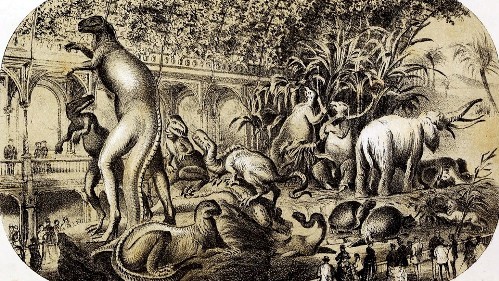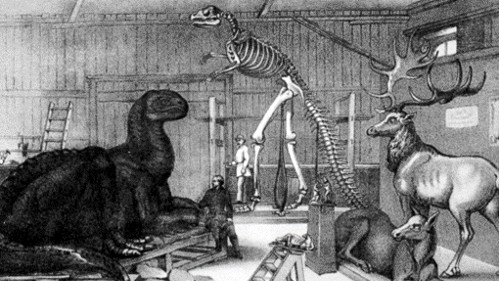New York's first dinosaur museum was trashed before it even opened. The culprit is not who we thought.
The crime, which had been attributed to a rogue politician called "Boss" Tweed, was likely orchestrated by an "eccentric and destructive" man with an obsession for white paint.
In 1871, vandals with sledgehammers destroyed skeletons and models intended for display in New York's first dinosaur museum before the building was even completed.
Contemporary news reports blamed the corrupt politician William "Boss" Tweed, but researchers have now revealed that the true culprit was likely Henry Hilton, who was seemingly obsessed with white paint and had "a remarkable ability to destroy everything he touched," according to researchers who have revisited the events.
Hilton was the vice-president and treasurer of Central Park, where the Paleozoic Museum was to be erected to provide education and entertainment for the public. But records show he favored a competing project to develop the American Museum of Natural History, which may have partly motivated the destruction of artifacts intended for the Paleozoic Museum, researchers wrote in a study published May 10 in the journal Proceedings of the Geologists' Association.
"Reading these reports, something didn't look right," co-author Vicky Coules, a researcher in the Department of History of Art at the University of Bristol in England, said in a statement. "So we went back to the original sources and found that it wasn't Tweed."
Commissioners developing Central Park were inspired by a display in England called the Crystal Palace Dinosaurs and enlisted the help of its creator, a natural history artist named Benjamin Waterhouse Hawkins. Hawkins arrived in America in 1868 and began collecting dinosaur and other prehistoric fossils, which he stored in a workshop near the park.
There, Hawkins pioneered the "hidden" metal armature still used today to hold skeletons in a lifelike stance and built full-size mounts of the dinosaurs Hadrosaurus foulkii and Laelaps aequilunguis. Drawings of the workshop reveal that Hawkins kept skeletons of modern flightless birds, which he used as analogs for bipedal dinosaurs, according to the study.
Related: 'Truly gigantic' Jurassic sea monster remains discovered by chance in museum
Get the world’s most fascinating discoveries delivered straight to your inbox.

But in 1870, Tweed, who was at the height of his power, replaced the Central Park commissioners with his own team and abruptly canceled plans for the Paleozoic Museum, dismissing Hawkins. Two months later, a gang of workmen committed the greatest act of vandalism in the history of dinosaur study and museum development, when they trashed Hawkins' studio and destroyed all the artifacts they could find.
"Previous accounts of the incident had always reported that this was done under the personal instructions of 'Boss' Tweed himself, for various motives from raging that the display would be blasphemous, to vengeance for a perceived criticism of him in a New York Times report of the project's cancellation," co-author Mike Benton, a professor of vertebrate paleontology at the University of Bristol in England, said in the statement.
But when the researchers analyzed documents linked to the incident, the evidence didn't add up. Tweed would have had bigger fish to fry at the time the crime was committed, Coules said. "Tweed was fighting for his political life, already accused of corruption and financial wrongdoing, so why was he so involved in a museum project?" The timing of the vandalism operation also didn't align with that of the critical New York Times article.
A closer look at original sources revealed that Tweed had appointed Hilton as treasurer of Central Park and tasked him with establishing the American Museum of Natural History. In a meeting of the Central Park board which Tweed was absent from, Hilton clearly stated his intention to do away with Hawkins' workshop, according to the study. While it is still possible that Tweed was pulling the strings behind the scenes, the researchers did not find evidence to suggest that he was.
The researchers also found that Hilton was notorious for his questionable decision-making. "Hilton exhibited an eccentric and destructive approach to cultural artifacts and a remarkable ability to destroy everything he touched," they wrote. He insisted that a statue of Eve at the Fountain in Central Park and a whale skeleton donated to the museum be painted white, for example. Both were damaged and could not be restored afterwards.Hilton later cheated a widow out of her inheritance, squandered his fortune and destroyed others' businesses and livelihoods as he went through life, according to the statement.
Hawkins was never compensated for his dismissal, but identifying the likely culprit sheds new light on the curious case of Central Park's dinosaurs. "This might seem like a local act of thuggery but correcting the record is hugely important in our understanding of the history of paleontology," Benton said.

Sascha is a U.K.-based staff writer at Live Science. She holds a bachelor’s degree in biology from the University of Southampton in England and a master’s degree in science communication from Imperial College London. Her work has appeared in The Guardian and the health website Zoe. Besides writing, she enjoys playing tennis, bread-making and browsing second-hand shops for hidden gems.



